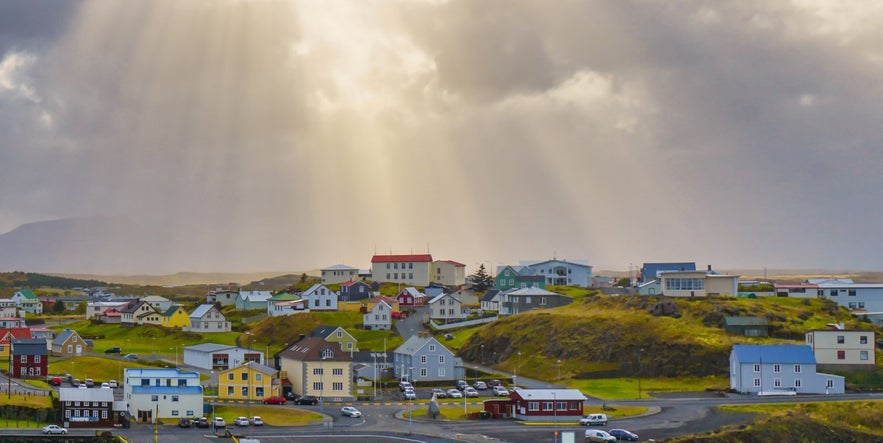
この町はアイスランドのセルフドライブツアーで訪れることができます。
スティッキスホルムルの歴史
スティッキスホルムルは、自然の良港とブレイザフィヨルズルの豊かな漁場へのアクセスの良さから、古くから人々を惹きつけてきました。
当サイトの情報が信頼できる理由
Guide to Icelandは、毎年何百万人もの旅行者に利用されているアイスランド最大級の旅行プラットフォームです。すべてのコンテンツは、アイスランドに精通した現地の専門家によって執筆・監修されています。正確で最新、信頼できる旅行情報をお届けしますので、安心してご利用ください。
この町は早くから人が住み始めたため、(名前こそ登場しないものの)アイスランドのサガ、特に名作「ラクセイラのサガ」にも登場します。この物語は、アイスランド文学の中でも特に情熱的で力強い女性主人公グズルーン・オスヴィフスドッティルが、4人の夫を失う運命と闘いながら、子どもたちを守ろうとする姿を描いています。
物語によると、彼女は最終的にアイスランド初の修道女となり、亡くなった後はスティッキスホルムル近くの小さな山ヘルガフェットルに埋葬されたと伝えられています。
しかし、町が本格的に発展し始めたのは1550年、交易所が設立されてからです。当時、アイスランドでは大西洋を渡る危険や距離の問題から交易所は珍しかったのですが、スティッキスホルムルの自然港がそれを可能にしました。
 その後、1602年から18世紀末まで続いたデンマークの貿易独占政策により、町はさらに発展しました。この政策は多くのアイスランド人にとって不利益でしたが、スティッキスホルムルのような半島の町の発展には寄与しました。
その後、1602年から18世紀末まで続いたデンマークの貿易独占政策により、町はさらに発展しました。この政策は多くのアイスランド人にとって不利益でしたが、スティッキスホルムルのような半島の町の発展には寄与しました。
デンマークによる植民地支配時代、アイスランド人は複雑な感情を抱いていましたが(現在ではスポーツ以外ほとんど癒えています)、スティッキスホルムルは昔からデンマークとの良好な関係を保ってきました。
1994年以降、毎年8月の第3週末には「デンマークの日」が開催され、町とデンマークの歴史的・現在のつながりを祝っています。また、デンマークのコリング市とは姉妹都市提携を結んでいます。
スティッキスホルムルの文化
スティッキスホルムルは、規模の割に文化的にも豊かな町です。ノルウェーハウスという博物館があり、これはアイスランド最古の2階建て建築(1828年築)で、当時の裕福なアイスランド人の暮らしを知ることができます。他にも火山博物館や、1845年創設の国内最古の気象観測所もあります。
映画『LIFE!(ウォルター・ミティの秘密の生活)』では、グリーンランドのシーンがスティッキスホルムルで撮影されました。また、小説『レッド・ストーム作戦発動』では、アメリカ軍がソ連からアイスランドを解放する際の上陸地点として描かれています。
スティッキスホルムルでできること

写真:スナイフェルスネス半島からフラテイ島経由でウェストフィヨルドへ向かう2.5時間のバルドゥルフェリー
町は小さいですが、スティッキスホルムルでできることはたくさんあります!主な見どころをいくつかご紹介します。
-
ブレイザフィヨルズル湾のボートツアー:この美しい湾には3,000以上の小島が点在しており、ボートツアーで間近に見ることができます。ツアーはスティッキスホルムル港から年間を通じて出発しています。
-
町歩き:スティッキスホルムルはカラフルな家々と絵のように美しい港が魅力の町です。のんびりと散策し、写真撮影を楽しみましょう。
-
ウォーター・ライブラリーの見学:町を見下ろす丘の上にあるユニークなアートインスタレーションです。アイスランド各地の氷河から集めた水がガラスの柱に収められています。
-
スナイフェルスネス国立公園の探索:半島の広大なエリアをカバーする国立公園で、アイスランド屈指の絶景スポットが点在しています。スナイフェルスヨークトル氷河、キルキュフェットル山、ディューパロンサンドゥルの黒砂海岸などが有名です。
-
ノルウェーハウスの見学:歴史ある木造建築を利用した博物館で、かつてノルウェー人商人の邸宅でした。スティッキスホルムルと周辺地域の歴史を紹介しています。
-
ハイキングやバードウォッチング:町周辺には初心者向けから上級者向けまでさまざまなハイキングコースがあります。また、多くの野鳥が生息しており、バードウォッチングにも最適です。
-
温泉でリラックス:周辺にはランドブロタロイグ温泉など、いくつかの温泉があります。自然に囲まれた小さな温泉で、ゆったりと温まることができます。
スティッキスホルムル周辺の見どころ
 スティッキスホルムルはスナイフェルスネス半島の北側に位置し、周辺には素晴らしい自然スポットが数多くあります。特に有名なのはキルキュフェットル山とスナイフェルスヨークトル国立公園です。
スティッキスホルムルはスナイフェルスネス半島の北側に位置し、周辺には素晴らしい自然スポットが数多くあります。特に有名なのはキルキュフェットル山とスナイフェルスヨークトル国立公園です。
キルキュフェットル山は「アイスランドで最も写真に撮られる山」とも呼ばれ、海辺からピラミッドのようにそびえ立ち、さまざまな角度からその美しさを楽しめます。特に、近くの滝キルキュフェットルスフォスのそばからの眺めは格別です。
スナイフェルスヨークトルは、アイスランドに3つある国立公園のひとつで、氷河と火山が象徴的な存在です。この壮大な双峰は、ジュール・ヴェルヌの小説『地底旅行』やハルドル・ラクスネスの『氷河の下で』などにも登場します。
また、スナイフェルスヨークトルは伝説や神秘に包まれており、半島の守護霊が住む場所、または不思議なエネルギーの中心地とも言われています。かつてはUFOが着陸すると予言され、アメリカのニュースクルーを含む多くの人々が集まったこともありました。
スナイフェルスネス半島の南側にも、ロゥンドランガルの玄武岩の断崖、イートリ・トゥンガのアザラシ観察ビーチ、ロイザフェルスギャゥ峡谷など、見どころがたくさんあります。










